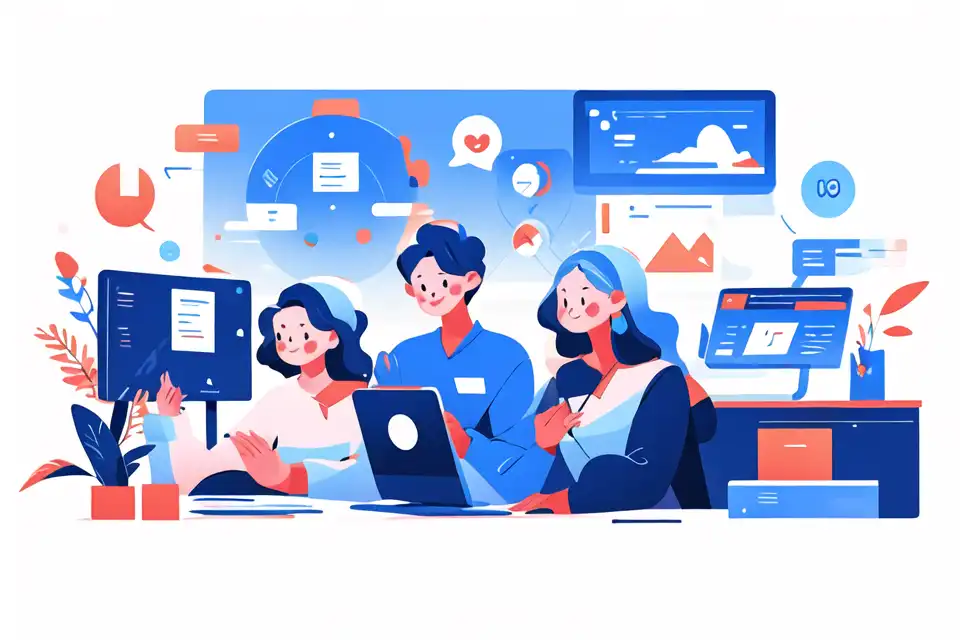AI In Employee Training
Learn about the top tips and strategies in AI in employee training.
Try Lark for Free
In the era of rapid technological advancements, the workplace environment is not left untouched. Traditional employee training methods are being replaced by AI-enabled solutions, transforming the way organizations educate and empower their workforce. This comprehensive guide unravels the intricacies of AI in employee training, exploring its transformational role, implementation strategies, real-world applications, and future trends.
"Unlock the power of Lark to elevate your business operations."
The business landscape of ai in employee training
Understanding the AI-empowered Training Environment
Artificial Intelligence, with its capacity for self-learning and automation, has revolutionized training methods. By understanding individual learning patterns and customizing content accordingly, AI creates a personalized training environment that enhances knowledge retention and overall productivity.
The Corporate Ecosystem and AI's Role
In the corporate world, AI streamlines the training process, eliminating the need for repetitive tasks and reducing human error. It also provides analytics that help in identifying skill gaps and tracking progress, thereby improving the quality of training.
Trends, Statistics, and Research
Research indicates a growing trend towards AI in employee training. According to a report published by LinkedIn, 82% of L&D (Learning and Development) professionals anticipate that AI will be widely incorporated into their learning programs within the next three years.
The transformational role of ai in employee training
AI and Workplace Productivity: A Dynamic Duo
AI enhances workplace productivity by automating routine tasks, providing personalized learning experiences, and offering actionable insights. AI-powered platforms like Lark help employees learn at their own pace, thereby boosting their confidence and work output.
The Perks: Benefits for Organizations and Employees
AI in employee training provides numerous benefits, such as improved learning management, cost-effectiveness, time-saving, and the creation of a tech-savvy workforce. For employees, it offers flexible learning schedules, personalized content, and continuous learning opportunities.
Learn more about Lark can help you with everything mentioned in the article.
Strategies for implementing ai in employee training
Steps for AI Integration in Workplace Learning Processes
Implementing AI in employee training involves a step-by-step process that includes assessing training needs, choosing the right AI tool, integrating AI with existing systems, and continually monitoring its effectiveness.
Best Practices and Methodologies for Effective Adoption
Best practices for implementing AI in training include setting clear objectives, focusing on employee engagement, and ensuring data privacy. It's also important to provide employees with the necessary support during the transition period.
Technological tools for ai in employee training
Tools, Platforms, and AI Technologies for Employee Training
Numerous AI tools and platforms are available for employee training. For instance, Lark offers AI-powered features such as automatic transcription and translation, which make learning materials accessible to a diverse workforce.
Harmonizing AI Training with Existing Business Systems
For a seamless transition, AI training tools should be compatible with existing business systems. Lark, for example, can be integrated with various third-party apps, ensuring a smooth workflow.
Learn more about Lark can help you with everything mentioned in the article.
Diving into real-world applications: case studies
Successful organizations riding the ai training wave
Successful organizations riding the ai training wave
Numerous organizations have successfully adopted AI in employee training. These case studies illustrate how AI can enhance learning outcomes and drive business growth.
Learning from success: key takeaways
Learning from success: key takeaways
These case studies provide valuable insights into the practical application of AI in employee training, and offer key takeaways that can be used to refine training strategies.
Overcoming challenges in ai-empowered employee training
Potential Obstacles and Risks: Data Privacy and Job Displacement
Despite its benefits, AI in employee training poses certain challenges, such as data privacy concerns and the fear of job displacement. It's crucial for organizations to address these issues and ensure a safe and secure learning environment.
Mitigation Strategies: Solutions for AI Training Challenges
To overcome these challenges, organizations can implement data protection measures, provide reassurances about job security, and offer training for skill upgradation.
Learn more about Lark can help you with everything mentioned in the article.
Preparing for the future: emerging trends in ai employee training
Novel Applications of AI in Various Industry Sectors
AI is finding new applications in various industry sectors. With its ability to adapt to changing learning needs, AI is set to redefine the future of employee training.
Future-proofing: Adapting to Evolving Workforce Trends
As AI continues to evolve, businesses must stay ahead of the curve by adopting the latest AI-powered training tools and methodologies. This will ensure that they are well-equipped to meet the changing needs of the workforce.
Conclusion: the ai impact on workplace dynamics
AI is transforming the workplace dynamics by redefining employee training. Its ability to personalize learning, streamline processes, and provide actionable insights is driving higher productivity and growth. As we move forward, AI's role in employee training is set to become even more significant.
Learn more about Lark can help you with everything mentioned in the article.
Practical application of ai in employee training with lark
With its suite of AI-powered tools, Lark is changing the way businesses conduct employee training. Its automatic transcription and translation features, integration with third-party apps, and personalized learning experiences make it a perfect choice for businesses looking to enhance their training programs.
Learn more about Lark can help you with everything mentioned in the article.
Do's and dont's for implementing ai in employee training
| Do's | Dont's |
|---|---|
| Set clear objectives | Ignore data privacy concerns |
| Focus on employee engagement | Overlook the need for support during the transition |
| Ensure compatibility with existing systems | Neglect to monitor the effectiveness of AI |
Step-by-step guide to implementing ai in employee training with lark
- Assess your training needs and objectives
- Choose Lark as your AI tool for employee training
- Integrate Lark with your existing systems
- Roll out the new training program to your employees
- Provide necessary support during the transition period
- Continually monitor the effectiveness of the AI-powered training program
With the right strategies and tools, businesses can leverage AI to transform their employee training, enhance productivity, and drive growth. As we move into the future, AI's role in employee training is set to become even more significant, making it an essential component of every organization's learning strategy.
"Unlock the power of Lark to elevate your business operations."








